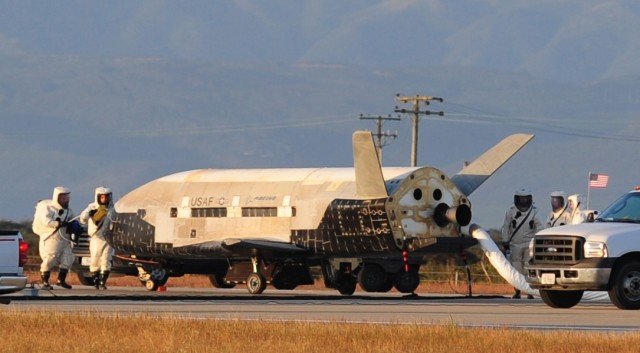NASA's Secretive X-37B Orbital Test Vehicle
The X-37B, also known as the Orbital Test Vehicle (OTV), the Air Force’s autonomous space shuttle, returned to Earth May 7th of this year after nearly 2 years in orbit. “The craft received the ground-issued command to return to Earth, initiating a fully autonomous sequence of events to fire its propulsion system and brake from orbit” (Ray, 2017). It autonomously landed on a runway much like an airplane. The intended purpose of the autonomous X-37B as described by the US Air Force is to demonstrate reusable space technologies. Detailed information is mostly secret and those without clearance and need to know are only really able to make educated guesses as to what the X-37B has been built to accomplish, or what it has been doing on its 4 flights into orbit.
The X-37B launches into space much like a satellite, on top of Atlas 5 rockets that propel and release it into orbit. James Andrew of the Center for Strategic and International Studies believes that the X-37B carries payloads to test future reconnaissance satellites considering that the Air Force seeks to develop smaller surveillance sensors to reduce the size and signature of satellites (Smith-Strickland, 2016). The X-37B has also carried other payloads on its missions. As per information publicly released, a new thruster called the XR-5A was included on the last mission for testing. The XR-5A is a five-kW Hall Thruster, which offers improved performance and operating range at reduced fuel consumption which will allow for smaller, cheaper rockets. The X-37B also took with it around 100 different materials to expose them to the space environment and test their performance.
Boeing’s director of experimental systems, Ken Torok, said of the X-37B, “Reliability, reusability, and responsiveness of the X-37B will fundamentally change how we perform future space missions” (Ray, 2017). It is a highly maneuverable space vehicle (Dockrill, 2017). One of the considerations for the use of the vehicle was to meet and repair satellites in orbit using robotic arms. Being an autonomous system, the X-37B could potentially replace humans in space for a variety of tasks. Without the need for life support considerations and room for humans to occupy the craft, space shuttles like the X-37B can be made much smaller and cheaper than manned counterparts and fulfill similar roles. “The X-37B is 8.9 meters long, 2.9 meters tall and has a wingspan of 4.5 meters. It has a loaded weight of 4,990 Kilograms. It features two angles tail fins. The Payload Bay of the vehicle is about 2.1 by 1.2 meters in size” (SpaceFlight101, 2017). It resembles a smaller version of a manned space shuttle and orbits at low altitude. Unlike most satellites, the X-37B orbits at low altitude and is designed to return to Earth for reuse. “Low orbits require more maneuvering, and therefore more fuel, to maintain” (Smith-Strickland, 2016). However, the X-37B would be able to overcome many of these challenges. “The laws of orbital dynamics and the fact that rockets use fuel at an alarming rate means satellites and spacecraft are not maneuverable like fighter aircraft within Earth’s atmosphere. Minimizing fuel use also demands the use of Hohmann transfer trajectories to move between orbits, reducing their orbital agility even further” (Davis, 2016).
The implications of the X-37B is that it is the bridge and the testing ground for advances in a wide range of space technology and application – communications, maneuverability, surveillance, presence, maintenance, re-usability, efficiency, and cost.
I think one of the weaknesses to the design is that it has to piggy back into orbit on a Atlas rocket. Another DARPA program, the XS-1 is a spacecraft that resembles a mix between a space shuttle and a jet that would be able to take off into orbit like a rocket on its own and return and land like the X-37B, to be used again (DARPA, 2017).
References:
DARPA. (2017). DARPA picks design for next-generation spaceplane. Darpa.mil. Web. 1 July 2017.
Davis, M. (2016). Why russia and china should fear the X-37B space plane. The National Interest. Web. 1 July 2017.
Dockrill, P. (2017). The air force's mysterious X-37B just landed after a record-breaking 718 days in orbit. ScienceAlert. Web. 1 July 2017.
Ray, J. (2017). X-37B spaceplane returns to earth and makes autopilot landing in florida. Spaceflightnow.com. Web. 1 July 2017.
Smith-Strickland, K. (2016). What’s the X-37 doing up there? Air & Space Magazine. Web. 30 June 2017.

Great article